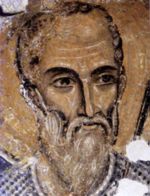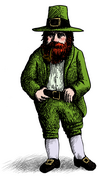Portal:Holidays/Selected biography/1 Frosty the Snowman Christmas song written by Walter E. "Jack" Rollins and Steve Nelson and recorded by Gene Autry and the Cass County Boys in 1950 . Like Jingle Bells and several other songs about winter, Frosty the Snowman is considered to be a Christmas song despite not mentioning Christmas at all. It was written after Gene Autry recorded "Rudolph the Red-Nosed Reindeer " and the single sold 2 million copies.
Frosty the Snowman is also a thirty-minute
animated television special based on the
popular song of the same title . The program, which first aired in
1969 , was produced for television by
Rankin/Bass and featured the
voices of comedians
Jimmy Durante as narrator and
Jackie Vernon as the title character.
Portal:Holidays/Selected biography/2 Rudolph the Red-Nosed Reindeer Christmas story about Santa Claus ' ninth and lead reindeer who possesses an unusually red colored nose that gives off its own light that is powerful enough to illuminate the team's path through inclement weather. The story is owned by St. Nicholas Music Inc. and has been sold in numerous forms including a popular song , a television special , and a feature film . Rudolph was created by Robert L. May in 1939 as part of his employment with Montgomery Ward .
Rudolph is an extension of
Santa's reindeer which pull his sleigh and help him deliver
Christmas gifts. The names of the original eight reindeer are taken from the
1823 poem
A Visit from St. Nicholas , which led to the popularity of reindeer as Christmas symbols.
Portal:Holidays/Selected biography/3 Saint Nicholas is the common name for Saint Nicholas,
Bishop of
Myra , who had a reputation for secret
gift -giving, but is now commonly identified with
Santa Claus . Among
Orthodox Christians , the historical Saint Nicholas is remembered and revered. Saint Nicholas is the
patron saint of sailors, merchants,
archers , children, and students in
Greece ,
Bulgaria ,
Georgia (country) ,
Russia , the
Republic of Macedonia ,
Slovakia ,
Serbia and
Montenegro . He is also the patron saint of
Barranquilla (
Colombia ),
Bari (
Italy )
Amsterdam (
Netherlands ), and of
Beit Jala in the
West Bank of
Palestine .
Portal:Holidays/Selected biography/4 Punxsutawney Phil is a
groundhog and the most famous resident of
Punxsutawney, Pennsylvania . On
February 2 (
Groundhog's Day ) of each year, the town of Punxsutawney celebrates the beloved groundhog with a festive atmosphere of music and food. During the ceremony, which begins well before the winter sunrise, Phil emerges from his temporary home on Gobbler's Knob, located in a rural area about 2 miles east of town. According to the
tradition , if Phil sees his shadow and returns to his hole, the
United States will suffer six more weeks of
winter . If Phil does not see his shadow,
spring will arrive early.
Portal:Holidays/Selected biography/5 Martin Luther King Jr. (January 15, 1929 – April 4, 1968) was a famous leader of the
American civil rights movement , a political activist, and a
Baptist minister. In 1964, King became the youngest man to be awarded the
Nobel Peace Prize . On April 4, 1968, Dr. King was assassinated in
Memphis, Tennessee . In 1977, he was posthumously awarded the
Presidential Medal of Freedom by
Jimmy Carter . In 1986,
Martin Luther King Jr. Day was established as a
United States holiday , only the fourth Federal holiday to honor an individual. In 2004, King was posthumously awarded the
Congressional Gold Medal . King's most influential and well-known public address is the "
I Have a Dream " speech, delivered on the steps of the
Lincoln Memorial in Washington, D.C.
Portal:Holidays/Selected biography/6 Guy Fawkes (13 April 1570 – 31 January 1606), also known as
Guido Fawkes was an
English military man and member of a group of
Roman Catholics who attempted to carry out the
Gunpowder Plot on 5 November 1605. "The Gunpowder Plot" was a plan to
assassinate the Protestant
King James I and the members of both houses of the
Parliament of England , by blowing up
Westminster Palace , in which the king addressed a joint assembly of both the
House of Lords and the
House of Commons . His activities were detected before the plan's completion, and following a severe interrogation involving the use of
torture and a trial in
Westminster Hall , he and his co-conspirators were executed for
treason and
attempted murder . Fawkes's failure (or the attempt) is remembered by
Guy Fawkes Night (also known as Bonfire Night or Fireworks Night) on
5 November .
Portal:Holidays/Selected biography/7
In
Irish mythology , a
leprechaun is a type of male
faerie said to inhabit the island of
Ireland . They are a class of "
faerie folk" associated in Irish mythology and folklore, as with all faeries, with the
Tuatha Dé Danann and other quasi-historical races said to have inhabited Ireland before the arrival of the
Celts . Leprechauns and other creatures of Irish mythology are often associated with "
faerie forts " or "
faerie rings " — often the sites of ancient
earthworks or
drumlins . They are said to be very rich, having many treasure crocks buried during war-time. According to legend, if anyone keeps an eye fixed upon one, he cannot escape, but the moment the eye is withdrawn he vanishes.
Portal:Holidays/Selected biography/8
In
Roman mythology ,
Cupid is the
god of
erotic love . He is equated with the
Greek god
Eros , and another one of his Latin names Amor. In
popular culture Cupid is frequently shown shooting his bow to inspire romantic love, often as an icon of
Valentine's Day . The most common representations of cupid include a chubby baby with wings and a bow and arrow. Sometimes the arrow has a heart for its tip. Cupid is most often seen
nude or
diapered . Cupid is sometimes blindfolded, symbolising the
figure of speech , "
love is blind ."
Portal:Holidays/Selected biography/9 Father Time is a
personification of
time . He is usually depicted as an elderly bearded man, dressed in a robe, carrying an
hourglass or other timekeeping device. This image is culled from several sources, including the
Holly King , the
Celtic god of the dying year, and
Chronos , the
Greek god of time. Because of their similarity in name as pertaining to parental figures, he is sometimes paired with
Mother Nature as a married couple. Sometimes, due to the relationship between death and aging, Father Time is associated with the
Grim Reaper .
Portal:Holidays/Selected biography/10 Ebenezer Scrooge is the
main character in
Charles Dickens '
1843 novel,
A Christmas Carol . He is a very cold-hearted, selfish man, who has no love for Christmas, children, or anything that even provokes happiness. The story of his transformation by the three Ghosts of Christmas (
Past ,
Present , and
Yet to Come ) has become a defining tale of the
Christmas holiday in some cultures. Scrooge's phrase, "Bah,
humbug !" has been used to express disgust with Christmas traditions in modern times. The inspiration for Charles Dickens' character was a grave marker for an Ebenezer Lennox Scroggie.
Portal:Holidays/Selected biography/11
The
domesticated turkey is a large
poultry bird raised for food. The modern domesticated turkey descends from the
wild turkey , one of the two species of
turkey ; however, in the past the
ocellated turkey was also domesticated. Turkeys are traditionally eaten as the main course of large feasts at
Christmas in Europe and North America, as well as
Thanksgiving in the
United States and
Canada , in both cases having displaced the traditional
goose . While eating turkey was once mainly restricted to special occasions such as these, turkey is now eaten year round and forms a regular part of many diets.
Portal:Holidays/Selected biography/12 Christopher Columbus was a
navigator and
maritime explorer credited as the
discoverer of the Americas . He had noted in his lifetime that he was born in
Genoa , Italy. His birth name was Cristoforo Colombo. He eventually became an
admiral for the
Crown of Castile . Columbus' voyages across the
Atlantic Ocean began a
European effort at
exploration and
colonization of the
Western Hemisphere . The anniversary of the 1492 voyage,
Columbus Day , is observed throughout the Americas and in
Spain .
Portal:Holidays/Selected biography/13 The Grinch is a popular
cartoon character created by
Dr. Seuss . He first appeared in the 1957
children's book ,
How the Grinch Stole Christmas! . The Grinch also has become a
cultural icon , mainly due to the massive popularity of his TV specials. Most notably, he is considered a
Christmas standard, and parodied/featured outside the
Dr. Seuss brand frequently around the
holiday season . Also, he is referenced by the media often in instances where a holiday display is ruined by vandals, or holiday burglaries are committed. Outside Christmas, the term "Grinch" is cognitive with "grouch".
Portal:Holidays/Selected biography/14 Portal:Holidays/Selected biography/14
Portal:Holidays/Selected biography/15 Portal:Holidays/Selected biography/15
Portal:Holidays/Selected biography/16 Portal:Holidays/Selected biography/16
Portal:Holidays/Selected biography/17 Portal:Holidays/Selected biography/17
Portal:Holidays/Selected biography/18 Portal:Holidays/Selected biography/18
Portal:Holidays/Selected biography/19 Portal:Holidays/Selected biography/19
Portal:Holidays/Selected biography/20 Portal:Holidays/Selected biography/20












